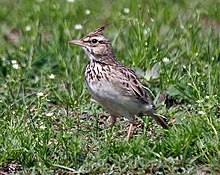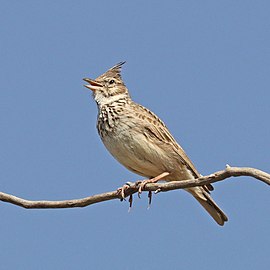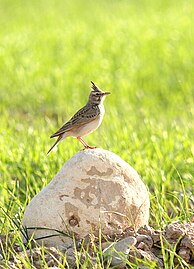Crested lark
| Crested lark | |
|---|---|

| |
| At Sultanpur National Park, India | |
| Scientific classification | |
| Domain: | Eukaryota |
| Kingdom: | Animalia |
| Phylum: | Chordata |
| Class: | Aves |
| Order: | Passeriformes |
| Family: | Alaudidae |
| Genus: | Galerida |
| Species: | G. cristata
|
| Binomial name | |
| Galerida cristata | |
| Subspecies | |
|
See text | |

| |
| Approximate range of G. cristata Breeding Resident
| |
| Synonyms | |
| |
The crested lark (Galerida cristata) is a species of
Taxonomy and systematics
The crested lark was one of the many species originally described by Carl Linnaeus in his landmark 1758 10th edition of Systema Naturae. It was classified in the genus Alauda until German naturalist Friedrich Boie placed it in the new genus Galerida in 1821. Colin Harrison recommended lumping members of Galerida and Lullula back into Alauda in 1865 due to a lack of defining characteristics.[2] The current scientific name is derived from Latin. Galerida was the name for a lark with a crest, from galerum, "cap", and cristata means "crested".[3] Alban Guillaumet and colleagues noted the distinctiveness of populations from the Maghreb - birds in the dryer parts of Morocco and Tunisia had longer bills while those in more coastal northern parts had shorter bills typical of the European subspecies. The authors sampled the mitochondrial DNA and found they were distinct genetically.[4]
Formerly, the Maghreb lark was considered as a subspecies of the crested lark.[5]
Subspecies
Thirty-three subspecies are recognized:[6]
- Iberian crested lark (G. c. pallida) - Brehm, CL, 1858: Found in Portugal and Spain
- Central European crested lark (G. c. cristata) - (Linnaeus, 1758): Found from southern Scandinavia and France east to Ukraine and Hungary
- West Italian crested lark (G. c. neumanni) - Hilgert, 1907: Found in west-central Italy
- Grecian crested lark (G. c. meridionalis) - Brehm, CL, 1841: Originally described as a separate species. Found from eastern Croatia to central Greece and western Turkey
- Cyprus crested lark (G. c. cypriaca) - Bianchi, 1907: Found on Rhodes, Karpathos and Cyprus
- South-east European crested lark (G. c. tenuirostris) - Brehm, CL, 1858: Found from eastern Hungary and Romania to southern Russia and Kazakhstan
- Caucasian crested lark (G. c. caucasica) - Aegean islands, northern Turkey and southern Caucasus
- North-west Moroccan crested lark (G. c. kleinschmidti) - Erlanger, 1899: Found in north-western Morocco
- West Moroccan crested lark (G. c. riggenbachi) - Hartert, 1902: Found in western Morocco
- North Algerian crested lark (G. c. carthaginis) - Kleinschmidt, O & Hilgert, 1905: Found from north-eastern Morocco to northern Tunisia
- North-east Algerian crested lark (G. c. arenicola) - Tristram, 1859: Originally described as a separate species. Found in north-eastern Algeria, southern Tunisia and north-western Libya
- Cyrenaica crested lark (G. c. festae) - Hartert, 1922: Found in coastal north-eastern Libya
- North-east Libyan crested lark (G. c. brachyura) - Tristram, 1865: Found from inland north-eastern Libya to southern Iraq and northern Arabia
- South-east Algerian crested lark (G. c. helenae) - Lavauden, 1926: Found in south-eastern Algeria and south-western Libya
- G. c. jordansi - Niethammer, 1955: Found in the Aïr Mountains (northern Niger)
- Nile Delta crested lark (G. c. nigricans) - Brehm, CL, 1855: Originally described as a separate species. Found in the northern Egypt)
- Northern Nile Valley crested lark (G. c. maculata) - Brehm, CL, 1858: Found in central Egypt
- Southern Nile Valley crested lark (G. c. halfae) - southern Egypt and northern Sudan
- Dongola crested lark (G. c. altirostris) - Brehm, CL, 1855: Originally described as a separate species. Found in eastern Sudan and Eritrea
- Somali crested lark (G. c. somaliensis) - Reichenow, 1907: Found in southern Ethiopia, northern Somalia and northern Kenya
- G. c. balsaci - Dekeyser & Villiers, 1950: Found in coastal Mauritania
- Senegal crested lark (G. c. senegallensis) - (Statius Müller, PL, 1776): Originally described as a separate species in the genus Alauda. Found from Mauritania and Senegal to Niger
- Nigerian crested lark (G. c. alexanderi) - western Sudan and north-eastern Central African Republic
- Sudan crested lark (G. c. isabellina) - Bonaparte, 1850: Originally described as a separate species. Found in central Sudan
- Coastal Levant crested lark (G. c. cinnamomina) - Hartert, 1904: Found in western Lebanon and north-western Israel
- East Levant crested lark (G. c. zion) - Meinertzhagen, R, 1920: Found from southern Turkey to north-eastern Israel
- Central Turkey crested lark (G. c. subtaurica) - (Kollibay, 1912): Found from central Turkey to south-western Turkmenistan and northern Iran
- Kazakhstan crested lark or Baluchistan crested lark (G. c. magna) - north-western China
- G. c. leautungensis - (eastern China
- G. c. coreensis - Taczanowski, 1888: Found in Korea
- Gilgit crested lark (G. c. lynesi) - Whistler, 1928: Found in northern Pakistan
- Indian crested lark (G. c. chendoola) - (northern India to southern Nepal
Description
A fairly small lark, the crested lark is roughly the same size as a
Distribution and habitat
The crested lark breeds across most of
This is a common bird of dry, open country and is often seen by roadsides or in cereal fields, although it is also found occupying small, sandy patches by railways, docks and airfields.[12]
Behaviour
The crested lark is a songbird, and has a liquid, warbling song described onomatopoeically as a whee-whee-wheeoo[9] or a twee-tee-too.[7] It sings in flight from high in the sky, at roughly 30 to 60 m (98 to 197 ft) above the ground. The related Eurasian skylark exhibits similar behaviour but also sings during its ascent, whereas the crested lark sings either at altitude or on the ground.[14] Their flight pattern is an example of undulatory locomotion.[9]
Breeding
It nests in small depressions in the ground, often in wastelands and on the outskirts of towns. The nests are untidy structures composed primarily of dead grasses and roots.[7] Three to five brown, finely speckled eggs, similar to those of the Eurasian skylark, are laid at a time and will hatch after 11–12 days.[14] As with most larks, the chicks leave the nest early, after about eight days and take flight after reaching 15–16 days old.[12] Two broods will usually be raised each year.
Food and feeding
Largely vegetarian birds, the crested lark primarily feeds on grains and seeds, such as oats, wheat and barley,[9] but will also eat insects, particularly beetles,[7] with food either being scavenged from the ground or dug up.[15] Juvenile birds are fed by both parents, and generally leave the nest before they are able to fly to start foraging for food themselves.
Relationship to humans
Status
The crested lark has been categorised by the
References
- ^ . Retrieved 12 November 2021.
- .
- ISBN 978-1-4081-2501-4.
- PMID 16473529.
- ^ Gill, F; D Donsker, eds. (30 June 2013). "Waxwings to swallows". IOC World Bird List: Version 3.4. International Ornithologists' Union. Archived from the original on 24 July 2011. Retrieved 30 July 2013.
- .
- ^ ISBN 070640405X.
- ^ ISBN 0198501889.
- ^ ISBN 0862724597.
- ISBN 9780789477644.
- ^ "Thousands flock to see rare bird". BBC News. 2 May 2009. Retrieved 28 July 2013.
- ^ ISBN 9781857327953.
- ISSN 0007-0335.
- ^ ISBN 0855330872.
- ^ Robinson, R.A. (16 January 2013). "Crested Lark Galerida cristata". BirdFacts. British Trust for Ornithology. Retrieved 28 July 2013.
- ISBN 0520019660.
- ^ a b "Species factsheet: Galerida cristata". BirdLife International. Retrieved 15 August 2022.





